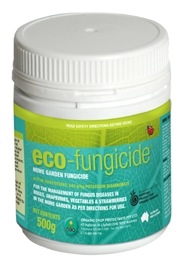 How many of you use bicarb soda in your garden? Maybe you’re familiar with it as a means to clean your house without chemicals, but do you know how good it is for controlling garden problems too?
How many of you use bicarb soda in your garden? Maybe you’re familiar with it as a means to clean your house without chemicals, but do you know how good it is for controlling garden problems too?
The use of baking soda to control fungal diseases attacking vegetables has been around for years – it’s what our grandparents used when they grew vegetables in their home garden. Back then, especially during the depression years, everyone had a couple of chooks and grew something in the backyard because they couldn’t afford to buy it. And they all had their own special home remedies for garden problems.
Many of today’s techniques used in organic gardening date back to these times, before the onslaught of chemical warfare during the WW2. People simply didn’t have access to the synthetic chemical solutions that line the shelves of our nurseries today, but they still managed to feed themselves successfully.
Now modern scientists can accurately support the effectiveness of the good old fashion remedies we once used. A report put together by George Kuepper, Raeven Thomas and Richard Earles, NCAT Agriculture Specialists and published on the National Sustainable Agricultural Information Service shows us how.
Testing showed how baking soda performed when it came to controlling powdery mildew (PM) on cucumber family plants, stating:
“A single spray application (to runoff) of 0.5% (wt./vol. of water) baking soda, plus 0.5% (vol./vol. of water) SunSpray UFP® horticultural oil almost completely inhibited PM on heavily infected pumpkin foliage. Baking soda without spray oil was ineffective”.
The addition of horticultural oil or liquid soap works as a surfactant, spreading the baking soda solution evenly over the leaf and helping it to stick to the plant. Baking soda was also shown to be equally effective on other fungal problems affecting potatoes, wheat, peanuts, banana and alfalfa.
It is important to note that the dilution rate of baking soda to water was proven to be a critical issue. Too little baking soda and it’s not effective, but too much baking soda will actually damaged the leaf. German scientists showed that the optimal concentration for controlling PM on grapes was a little higher, indicating that 1% was ideal.
But don’t be fooled, not all bicarbs are the same …. Testing with a range of bicarbs showed ammonium bicarb worked well for some things whereas sodium bicarbonate and potassium bicarbonate worked best on others. PM was more effectively treated when using potassium bicarbonate.
Sounding a bit too technical?
 Well, let me explain …common baking soda is what we buy in the supermarket for cooking and it’s sodium bicarb but potassium bicarb is a commercial gardening product. In Australia, we buy this as Eco-Fungicide
Well, let me explain …common baking soda is what we buy in the supermarket for cooking and it’s sodium bicarb but potassium bicarb is a commercial gardening product. In Australia, we buy this as Eco-Fungicide
Researchers showed that baking soda is best used for preventative measures rather than controlling outbreaks of fungal diseases. Although good results were achieved if it is also used just in the initial stages of outbreak.
For the home gardener wanting a home remedy then the recommendation was to use baking soda at a concentration of 4 teaspoons per gallon (or 1/2 teaspoon in a 450ml spray bottle filled with water) with the addition of equal quantities of biodegradable dish washing liquid or liquid soap as the bicarb (i.e 1/2 teaspoon)
Click here for a copy of the full report on “Use of Baking Soda as a Fungicide”




 Twitter
Twitter Facebook
Facebook
Thank you to the veggie lady for all that info, but also for having a picture there for me to identify that it is the exact problem which I see on my own zucchini plant. I’m going to give the home remedy a go this very night.
The site does not indicate how often I am to spray the plant or whether I should cut any leaves off if they are not looking healthy.
Kindest regards
Mary
Mary you should cut off any badly affected leaves so that the fungus doesn’t spread. Then spray weekly until the fungus has gone. Good luck!